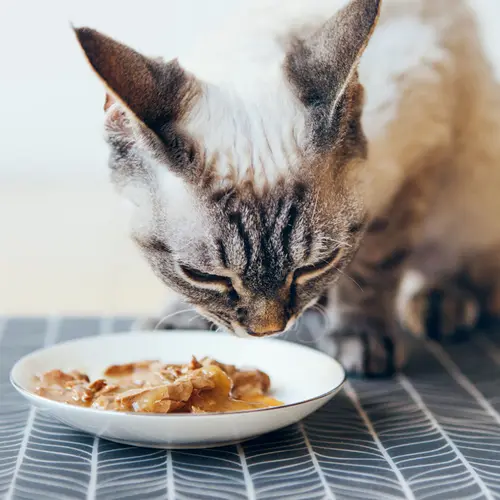If something rubs or damages the surface of your cat's eye, it may lead to corneal ulcers. If treated, most cat eye ulcers heal, but if left untreated, your cat's eye may be permanently damaged, leading to blindness or even loss of the eye.
What Is Cat Corneal Ulcer?
A cat corneal ulcer (or cat eye ulcer) is a wound that develops on the surface of a cat's eye. The most common cause of corneal ulcer in cats is trauma (injury) to the eye.
It may be difficult to see cat eye ulcers with the naked eye. This is why your vet may use a fluorescein stain to detect, diagnose, and monitor corneal ulcers in your cat. Your vet may place a drop of this orange-colored stain on the cornea. Ulcerated or damaged tissues will pick up the orange dye and turn green.
It is easy to see large cat eye ulcers, but special ophthalmic lights and filters may be needed to see tiny ulcers.
What Are the Causes of Cat Eye Ulcers?
Eye ulcers in cats are commonly caused by eye infections, catfight injuries, viral causes, and upper respiratory infections.
The most common cause of cat eye ulcers is trauma to the eye. Eye trauma could include blunt trauma, which can occur when your cat rubs their eye against a rough surface, or it could be sharp, such as eye injuries from a sharp object like a thorn or claw.
There are other causes of cat eye ulcers. Chemical burns of the cornea are also another common cause of corneal ulcers. Chemical burns may occur when irritating shampoos, chemicals, other liquids, or dust (such as drywall dust) get into the eyes. Other causes include a piece of dirt trapped under the eyelid, ingrown eyelashes, and viral or bacterial infection.
The most common infectious cause of corneal eye ulcers is recurrent infection with the feline herpesvirus (FHV).
What Are the Symptoms of Cat Eye Ulcers?
If your cat has an eye ulcer, they may have:
Eye inflammation. This is a common symptom of cat eye ulcers. The affected eye may become red and inflamed. This shows as an inflammation of the tissue that surrounds the cornea.
Weepy Eye. You may see some discharge from your cat's eye.
Painful eye. Your cat may squint, close its eye, or rub the affected eye. Your cat may also behave as if they have vision problems.
Cloudy eye. Your cat's cornea may appear cloudy.
Hypersensitivity. Your cat may show some hypersensitivity to bright light.
Depressed eye. There may be an obvious dip on the surface of the affected eye.
Your cat may also have a corneal ulcer without you noticing. This is because some corneal ulcers are not symptomatic enough to be noticed. If you do notice an ulcer, take your cat to the veterinarian as soon as possible.
What Is the Treatment for Cat Eye Ulcers?
Cat eye ulcer treatment will depend on the severity of the ulcer. Usually, your vet will focus on reducing the pain, controlling the inflammation, and preventing the spread of any fungal or bacterial infection.
With the right cat eye ulcer medication and careful nursing, cat eye ulcers can heal completely. Simple ulcers can heal within a week, but a more serious ulcer may take several weeks to heal.
Eye drops. Your vet may prescribe lubricating eye drops to help moisten the surface of your cat’s eye while the ulcer heals. If necessary, your vet will also prescribe antibiotic eye drops to treat or prevent infection.
Superficial ulcers can be treated quite effectively using an antibiotic ointment.
Other medication. Your vet may prescribe anti-inflammatory pain relief medications since your cat's eye may be visibly inflamed.
Cone/Buster/Elizabethan collars. Your cat may have to wear a cone collar to prevent them from scratching or touching their eye. Self-trauma can easily aggravate a corneal ulcer, interfering with the healing process.
A cone collar can help protect the eye while it heals. Unless your vet says otherwise, you should use one until the ulcer heals completely.
Treating the primary cause. It is important to identify the underlying cause of your cat's eye ulcer to treat it more effectively. Once you treat the underlying cause of the eye ulcer, most ulcers will start to heal.
For example, if the corneal ulcer is caused by the herpes virus, your vet may prescribe cidofovir or lysine to prevent the virus from replicating. If your cat experiences recurrent corneal ulcers (usually caused by FHV), your vet may have to put your cat on lysine therapy permanently.
If your cat's eye ulcer doesn't get better with treatment, your vet may recommend a full examination or referral to an ophthalmologist. This will usually happen when your cat is sedated or anesthetized. Your vet may recommend surgery to help the ulcer heal quickly. If a complex procedure is required, you may need to take your cat to a vet who specializes in eyes.
How Do I Prevent My Cat from Getting an Eye Ulcer?
Since trauma is a common cause of feline eye ulcers, you can reduce the chances of cat ulcers by removing objects that can cause trauma. Also, if your cat gets into lots of fights, you have to manage fighting and aggression. You may need to take your cat to the vet to see if the behavior is the result of an underlying medical condition.
It is recommended that all cats have their core vaccines. You can vaccinate your cat against feline herpesvirus (FHV) to prevent recurrent feline eye ulcers caused by the virus.
